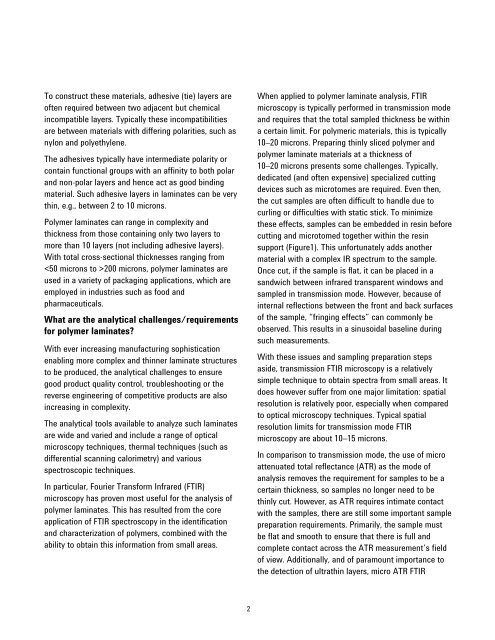Application Compendium - Agilent Technologies
Application Compendium - Agilent Technologies
Application Compendium - Agilent Technologies
You also want an ePaper? Increase the reach of your titles
YUMPU automatically turns print PDFs into web optimized ePapers that Google loves.
To construct these materials, adhesive (tie) layers are<br />
often required between two adjacent but chemical<br />
incompatible layers. Typically these incompatibilities<br />
are between materials with differing polarities, such as<br />
nylon and polyethylene.<br />
The adhesives typically have intermediate polarity or<br />
contain functional groups with an affinity to both polar<br />
and non-polar layers and hence act as good binding<br />
material. Such adhesive layers in laminates can be very<br />
thin, e.g., between 2 to 10 microns.<br />
Polymer laminates can range in complexity and<br />
thickness from those containing only two layers to<br />
more than 10 layers (not including adhesive layers).<br />
With total cross-sectional thicknesses ranging from<br />
200 microns, polymer laminates are<br />
used in a variety of packaging applications, which are<br />
employed in industries such as food and<br />
pharmaceuticals.<br />
What are the analytical challenges/requirements<br />
for polymer laminates?<br />
With ever increasing manufacturing sophistication<br />
enabling more complex and thinner laminate structures<br />
to be produced, the analytical challenges to ensure<br />
good product quality control, troubleshooting or the<br />
reverse engineering of competitive products are also<br />
increasing in complexity.<br />
The analytical tools available to analyze such laminates<br />
are wide and varied and include a range of optical<br />
microscopy techniques, thermal techniques (such as<br />
differential scanning calorimetry) and various<br />
spectroscopic techniques.<br />
In particular, Fourier Transform Infrared (FTIR)<br />
microscopy has proven most useful for the analysis of<br />
polymer laminates. This has resulted from the core<br />
application of FTIR spectroscopy in the identification<br />
and characterization of polymers, combined with the<br />
ability to obtain this information from small areas.<br />
2<br />
When applied to polymer laminate analysis, FTIR<br />
microscopy is typically performed in transmission mode<br />
and requires that the total sampled thickness be within<br />
a certain limit. For polymeric materials, this is typically<br />
10–20 microns. Preparing thinly sliced polymer and<br />
polymer laminate materials at a thickness of<br />
10–20 microns presents some challenges. Typically,<br />
dedicated (and often expensive) specialized cutting<br />
devices such as microtomes are required. Even then,<br />
the cut samples are often difficult to handle due to<br />
curling or difficulties with static stick. To minimize<br />
these effects, samples can be embedded in resin before<br />
cutting and microtomed together within the resin<br />
support (Figure1). This unfortunately adds another<br />
material with a complex IR spectrum to the sample.<br />
Once cut, if the sample is flat, it can be placed in a<br />
sandwich between infrared transparent windows and<br />
sampled in transmission mode. However, because of<br />
internal reflections between the front and back surfaces<br />
of the sample, ―fringing effects‖ can commonly be<br />
observed. This results in a sinusoidal baseline during<br />
such measurements.<br />
With these issues and sampling preparation steps<br />
aside, transmission FTIR microscopy is a relatively<br />
simple technique to obtain spectra from small areas. It<br />
does however suffer from one major limitation: spatial<br />
resolution is relatively poor, especially when compared<br />
to optical microscopy techniques. Typical spatial<br />
resolution limits for transmission mode FTIR<br />
microscopy are about 10–15 microns.<br />
In comparison to transmission mode, the use of micro<br />
attenuated total reflectance (ATR) as the mode of<br />
analysis removes the requirement for samples to be a<br />
certain thickness, so samples no longer need to be<br />
thinly cut. However, as ATR requires intimate contact<br />
with the samples, there are still some important sample<br />
preparation requirements. Primarily, the sample must<br />
be flat and smooth to ensure that there is full and<br />
complete contact across the ATR measurement’s field<br />
of view. Additionally, and of paramount importance to<br />
the detection of ultrathin layers, micro ATR FTIR

















